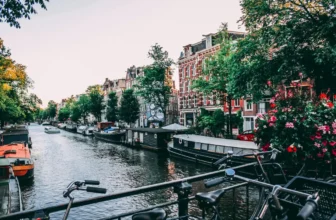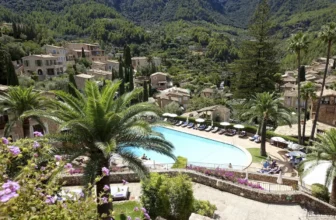
Located on Japan’s main island of Honshu lies the vibrant and historically rich Kansai region. Known for its iconic cities, cultural heritage, and delicious cuisine, Kansai presents travelers with a unique blend of the old and the new.
At the heart of the region are three ancient capitals – Nara, Kyoto, and Osaka – each of which has been instrumental in shaping Japan’s history and culture.
This journey through the capitals of Kansai is more than just a trip – it is a voyage back in time to the roots of Japanese civilization.
The Ancient Capital of Nara
Long before Tokyo, even before Kyoto, Nara was the first permanent capital of Japan. Established in 710 and known then as Heijo, Nara’s historical sites stand as a testament to its past grandeur.
The city’s centerpiece is the Todai-ji temple, home to the world’s largest bronze Buddha statue, a monumental figure standing over 15 meters tall. The temple, together with the surrounding structures, paints a vivid picture of the city in its prime.
Just a stone’s throw away from Todai-ji lies Kasuga Taisha, Nara’s most celebrated shrine. Known for its thousands of stone and bronze lanterns, the shrine exudes an almost ethereal atmosphere. Each lantern here has a story to tell, donated over centuries by worshippers seeking blessings.
Perhaps the most enchanting of Nara’s features is its famous deer park. Over a thousand deer roam freely here, considered sacred messengers of the Shinto gods.
Their gentle demeanor adds to the city’s tranquil and mystic charm, making a visit to Nara akin to stepping into another world.
The Cultural Heart of Kyoto
A trip to Kansai would be incomplete without a visit to Kyoto, Japan’s capital for over a thousand years and the cultural heart of the country. With over 2,000 temples and shrines dotting the city, Kyoto is like a vast, open-air museum dedicated to Japan’s cultural heritage.
Among Kyoto’s many treasures, the golden Kinkaku-ji stands out for its sheer brilliance. Covered in gold leaf, the temple shimmers in the sunlight, its reflection dancing on the mirror pond below.
On the other end of the city, Fushimi Inari Shrine enchants visitors with its iconic red torii gates that create a mesmerizing tunnel up the Inari mountain. The tranquillity at the top of the mountain provides a serene contrast to the hustle and bustle at the shrine’s base.
Yet, Kyoto’s charm extends beyond its temples. Its historic districts, like Gion, are famous for geishas and traditional wooden machiya houses. The city’s rich tradition is also evident in its festivals, tea ceremonies, and exquisite kaiseki cuisine.
Osaka: A Blend of the Old and New
Despite its ultra-modern appearance, Osaka’s roots dig deep into Japan’s history. It’s a city where the past and the present coexist, creating a dynamic urban landscape that’s brimming with energy.
The crowning glory of Osaka is its castle, an imposing structure surrounded by fortifications and moats. The castle, a symbol of Osaka, contrasts sharply with the city’s modern skyline, encapsulating Osaka’s journey through the ages.
Even as you walk through the bustling streets of Dotonbori, a famous street filled with neon lights and myriad food stalls, you can find traces of the old in the nooks and corners, be it a small shrine squeezed between commercial buildings or a quiet tea shop in the middle of the market.
Osaka is a testament to Japan’s extraordinary ability to embrace the new while respecting the old.
Furthermore, according to onlinecasinojapan.com, a website that reviews online casinos, Japan’s first casino resort is scheduled to open in 2029, with the design combining Japanese-style old gardens and buildings with the stunning image of a casino.
It may take some time before it opens, but it will undoubtedly become one of Osaka’s most popular tourist sites.
Comparing the Capitals
Each of Kansai’s ancient capitals offers a distinct perspective on Japan’s culture and history. While Nara is known for its tranquil atmosphere and sacred deer, Kyoto is revered for its traditional charm and numerous temples. Osaka, on the other hand, presents a delightful mix of the old and the new.
Osaka has the largest population, and the area around the station is always crowded with people. Nara is the quietest and least crowded tourist destination.
These three cities are very close to each other and can be reached by train in 30 minutes to an hour. If you visit Kansai, we recommend that you visit all three cities. By actually visiting, you will be able to feel the difference first-hand.
Travel Tips for Exploring the Ancient Capitals
Kansai’s extensive transportation network makes it easy for travelers to navigate the region. From Shinkansen (bullet trains) to local buses, numerous options are available for every kind of traveler. For accommodation, one can choose from luxury hotels, budget hostels, and traditional ryokans for an authentic experience.
Each city in Kansai also boasts its culinary specialties. Try takoyaki and okonomiyaki in Osaka, yudofu and matcha-flavored sweets in Kyoto, and kakinoha sushi, pressed sushi wrapped in persimmon leaves, in Nara.
The Kansai region, in particular, is known to offer better food than the Kanto region, which encompasses Tokyo and Yokohama, so we recommend spending a lot of money on Food.
Also, whereas Japanese people are generally regarded to be shy, Kansai residents are not. There is a culture of talking with strangers, so don’t be afraid to ask the locals if you have any questions.
However, it is best to acquire basic Japanese or utilize a translator because only a few Japanese understand English.
Conclusion
Our journey through Kansai’s ancient capitals is akin to flipping through the pages of a living history book. The serene deer park in Nara, the golden pavilion in Kyoto, and the modern lights of Osaka tell tales of a civilization that has seen centuries pass by.
The cities of Kansai, steeped in history and bustling with life, are a testament to Japan’s rich cultural heritage and relentless resilience.
As we traverse the streets of these ancient capitals, we don’t just travel in space but also in time, experiencing the captivating allure of Japan’s illustrious past, vibrant present, and the promise of an exciting future.






